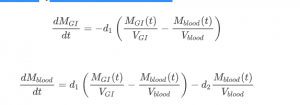Medicine model
Course subject(s)
2. Improving the model
Medicine model

Medicine concentrations
Simulate how the medicine in a pill someone takes enters into the bloodstream, does its work and is filtered out again.
Medicine model
Medication that you take orally, first dissolves in the contents of your stomach and intestines. Together those are called your gastrointestinal tract, or GItract for short. Then the medicine passes from the GI tract through the liver into the bloodstream. From the blood the medicine can reach the organ that needs it and do its work there. The kidney then clears the medicine out of the blood again. For many medicines it is best when the concentration in the blood is constant for a longer time.
In the following equations the quantities of medicine in the GI tract at time t are given by MGI(t) and Mblood(t) respectively. VGI is the volume of the contents in the GI tract and Vblood is the volume of blood of the person taking the medicine. In this model, the medicine passes from the GI tract to the blood (and from the blood to the kidney) by passive diffusion. So if the concentration of the medicine in the GI tract is higher than the concentration in the blood, the medicine diffuses with diffusion rate d1 from the GI tract to the blood.

The parameters d1 and d2 you will have to choose appropriately.
In Module 2 (starting from question 7 below) and in Module 3, use a simplified model. Take the concentration of the medicine in the stomach CGI=MGIV/GI constant. The model for Mblood(t) then reduces to:

Tasks for the project in Module 2
- Choose a medicine which you want to model. It should be a medicine that you take orally.
- Try to find quantitative information on the dosage. How long after you take a pill does it start working? How long does it keep working? How much of it are you advised to take? Do not forget to write down where you found the information!
- Describe in words the physical meaning of each quantity and term in the model.
- Decide on the unit you are going to use for MGI and Mblood: (m)mol or mg? Decide also on the unit for time t and the unit for volumes VGI and Vblood.
- Choose appropriate values for VGI and Vblood.
- Use the differential equations and determine the unit for diffusion constants d1 and d2.
- Now start with the simplified model: assume that MGI(t) is constant. Construct a phase line. Determine the equilibrium point. Is it stable?
- Some of you might have learned elsewhere how you can solve the simplified differential equation analytically. Then you could try to determine an appropriate value for d1 by first setting d2=0 and then adjusting d1 until solution is reasonable. You can also postpone determining d1 until you are able to simulate the solutions numerically.
Throughout, do communicate well with your teammate, so you make the different choices together. Document every result and decision in your logbook. That will help in the communication between you two, and when you are writing the report later on, you can find all your previous results easily.
The next page is for the questions you might have about the project.

Mathematical Modeling Basics by TU Delft OpenCourseWare is licensed under a Creative Commons Attribution-NonCommercial-ShareAlike 4.0 International License.
Based on a work at https://online-learning.tudelft.nl/courses/mathematical-modeling-basics/.



